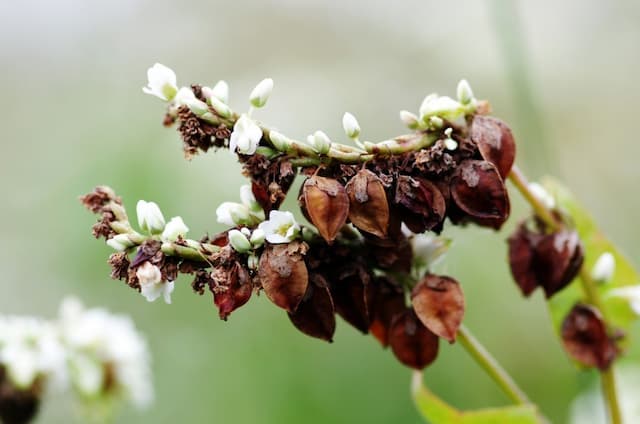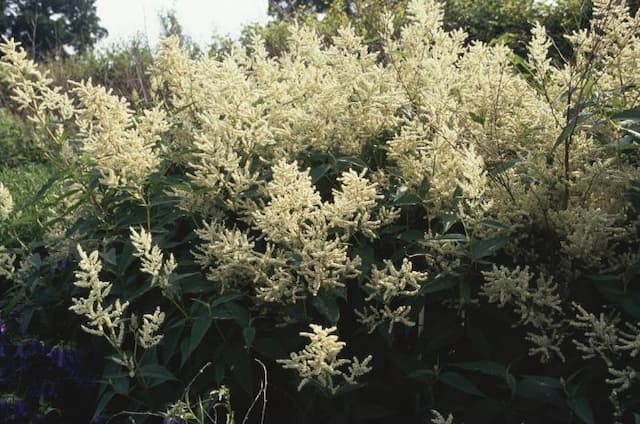Lesser knotweed Persicaria campanulata

ABOUT
The plant commonly known as lesser knotweed is a robust perennial herb known for its sprawling habit. The foliage of lesser knotweed is usually dense, with broad leaves that are heart-shaped at the base but pointy at the tips. The leaves are often deep green and can have a somewhat glossy texture, providing a lush background for its flowers. The blooming characteristic of lesser knotweed is quite distinctive, thanks to its dense, spike-like clusters of small, bell-shaped flowers. These blossoms are usually white or pale pink and are tightly packed along the flowering spikes. The plant has a scrambling nature and spreads via underground stems, which means it can form extensive patches, giving it a vigorous presence in its favored habitats. The flowers have a delicate appearance and attract various pollinators, adding to the ecological value of the plant. Lesser knotweed has a resilience that allows it to thrive in a variety of conditions, although it favors moisture-retentive soils and can often be found near water sources. The combination of its leafy foliage and attractive floral spikes makes it a plant that can stand out in garden settings, although its growth needs to be managed to prevent it from becoming invasive.
About this plant
 Names
NamesFamily
Polygonaceae.
Synonyms
Lesser Knotweed, Bellflower Smartweed, Rampion Smartweed, Korean Knotweed.
Common names
Polygonum campanulatum, Persicaria campanulatum.
 Toxicity
ToxicityTo humans
Lesser knotweed, the common name for Persicaria campanulata, is not widely known to be toxic to humans. There is limited information on the toxicity of this specific species to humans, and it does not have a reputation for being a poisonous plant. However, as with many plants, it is generally advised to avoid ingesting parts of the plant unless they are known to be edible, as they could cause stomach upset or an allergic reaction in some individuals. Always consult an expert or medical professional if ingestion has occurred and adverse effects are noted.
To pets
Lesser knotweed is not typically listed as a toxic plant to pets. However, the lack of specific information on the toxicity of Persicaria campanulata to pets means that caution should be exercised. In general, it is best to prevent pets from ingesting any plant material that is not verified as safe. If a pet does ingest Lesser knotweed and shows signs of illness such as vomiting, diarrhea, or unusual behavior, contact a veterinarian.
 Characteristics
CharacteristicsLife cycle
Perennials
Foliage type
Deciduous
Color of leaves
Green
Flower color
Pink
Height
2-3 feet (60-90 cm)
Spread
2-3 feet (60-90 cm)
Plant type
Herb
Hardiness zones
4
Native area
Himalayas
Benefits
 General Benefits
General Benefits- Erosion control - Persicaria campanulata, commonly known as lesser knotweed, has a dense rooting system that helps stabilize soil and prevent erosion.
- Wildlife habitat - It provides shelter and breeding ground for small animals, birds, and beneficial insects.
- Ornamental value - With its distinctive pinkish flowers, lesser knotweed is often used to add visual interest to gardens and landscapes.
- Low maintenance - Lesser knotweed is a hardy plant that requires minimal care once established, making it a good choice for low-maintenance gardens.
- Pollinator support - The flowers of the lesser knotweed attract pollinators such as bees and butterflies, contributing to pollination of surrounding plants.
- Ground cover - Its ability to spread and cover the ground quickly makes it effective for filling in bare spots and suppressing weeds.
 Medical Properties
Medical PropertiesThis plant is not used for medical purposes.
 Air-purifying Qualities
Air-purifying QualitiesThis plant is not specifically known for air purifying qualities.
 Other Uses
Other Uses- Persicaria campanulata, commonly known as lesser knotweed, serves as a forage plant for livestock, offering a supplementary food source for grazing animals.
- Lesser knotweed's dense growth habit provides erosion control on steep slopes or areas prone to soil displacement since its roots help to bind the soil effectively.
- The plant's attractive flowers can be used for casual floral arrangements, adding a wild and natural look to bouquets.
- With its rapid growth, lesser knotweed can be used as a privacy screen or living wall in gardens and landscapes where quick coverage is desired.
- Its capability to spread quickly makes it useful for covering unsightly areas in the garden, such as bare spots or utility fixtures.
- Enthusiasts of natural dyeing can utilize lesser knotweed to produce yellow and green dyes for fabrics, using different parts of the plant.
- Because this species can be invasive, ecologically minded gardeners might use it for controlled bioengineering projects, taking care to prevent unwanted spread.
- The foliage of lesser knotweed, with its broad leaves, can be used in garden mulching to suppress weeds and retain soil moisture.
- Lesser knotweed can be planted in buffer zones along waterways to filter runoff and improve water quality by trapping sediments and pollutants.
- The dense thickets formed by lesser knotweed provide shelter and habitat for small wildlife, including beneficial insects and birds.
Interesting Facts
 Feng Shui
Feng ShuiThe Persicaria campanulata, commonly known as Knotweed, is not used in Feng Shui practice.
 Zodiac Sign Compitability
Zodiac Sign CompitabilityThe Persicaria campanulata, commonly known as Knotweed, is not used in astrology practice.
 Plant Symbolism
Plant Symbolism- Adaptability: Persicaria campanulata, also known as Lesser knotweed, often thrives in a variety of conditions, symbolizing the ability to adapt and succeed in diverse environments.
- Resilience: Lesser knotweed is known for its tough and persistent nature, making it a symbol of resilience and the capacity to overcome challenges.
- Interconnectedness: The interlacing growth pattern of Lesser knotweed reflects the interconnectedness of all things and the importance of relationships in our lives.
- Growth: Like many plants, Lesser knotweed symbolizes growth, personal development, and the progression of life's stages.
- Prosperity: In some cultures, knotweed varieties are considered to represent prosperity and abundance, possibly due to their prolific growing habits.
 Water
WaterLesser knotweed should be watered regularly, ensuring that the soil is kept consistently moist but not waterlogged. During the growing season, which is from spring to fall, watering once a week with approximately 1 to 1.5 gallons of water should suffice, but this can vary depending on climate conditions. In periods of extreme heat or drought, you may need to increase watering frequency. During winter, reduce the amount to align with the plant's reduced water needs, generally every other week or less, depending on the temperature and soil dampness.
 Light
LightLesser knotweed thrives best in full sun to partial shade. The ideal location is a spot where the plant can receive at least 3 to 4 hours of direct sunlight daily, complemented by dappled or indirect light throughout the rest of the day. It is adaptable though, and can still grow in shadier conditions, but flowering may be less prolific.
 Temperature
TemperatureLesser knotweed prefers temperate climates. It is hardy and can survive a temperature range from around 5 to 89 degrees Fahrenheit. Ideally, maintain a temperature between 60 and 75 degrees Fahrenheit for optimal growth. It can survive light frosts, but extended freezing temperatures can damage the plant.
 Pruning
PruningPruning lesser knotweed promotes a more compact growth habit and encourages the plant to produce more flowers. Prune the plant in late winter or early spring before new growth starts. This usually involves cutting back the stems to around 4 to 6 inches above ground level. Additionally, deadhead spent flowers throughout the blooming season to maintain a neat appearance and to stimulate further flowering.
 Cleaning
CleaningAs needed
 Soil
SoilLesser knotweed thrives best in a rich, loamy soil that is well-draining and has a mildly acidic to neutral pH of 5.5 to 7.0. A good mix would be equal parts garden soil, compost, and perlite to ensure proper drainage and fertility.
 Repotting
RepottingLesser knotweed doesn't need frequent repotting and can be done every 2 to 3 years or when it outgrows its pot. Spring or early summer is the best time for repotting.
 Humidity & Misting
Humidity & MistingLesser knotweed prefers moderate to high humidity levels but is relatively adaptable. Aim to maintain a humidity level around 40-60% for optimal growth.
 Suitable locations
Suitable locationsIndoor
Place Lesser knotweed in bright, indirect light and water when top soil is dry.
Outdoor
Plant in partial shade, keep soil moist, and protect from extreme cold.
Hardiness zone
4-7 USDA
 Life cycle
Life cycleLesser knotweed (Persicaria campanulata) begins its life cycle when seeds germinate in moist, fertile soil, typically in spring or after the soil has warmed sufficiently. Seedlings emerge and develop into juvenile plants with characteristic lance-shaped leaves and a sprawling growth habit. Over time, these juveniles grow into mature plants, producing stems that may root at the nodes, spreading vegetatively. Flowering occurs in summer to autumn, with the plants producing small, bell-shaped white or pinkish flowers that are often arranged in spikes. Pollination is typically by insects, and successful fertilization results in the production of small, brown, three-angled seeds. The plant dies back in winter, especially in colder climates, but can resprout the following spring either from seeds or perennating structures, completing the life cycle.
 Propogation
PropogationPropogation time
Spring-early summer
Persicaria campanulata, commonly known as lesser knotweed or bellflower smartweed, is typically propagated through division, which is the most popular method for this plant. The best time to divide Persicaria campanulata is in early spring or fall when the plants are not in active growth. To propagate by division, carefully dig up an established clump of the plant and gently separate it into smaller sections, ensuring that each new section has a good amount of roots and shoots. These sections can then be immediately replanted into well-prepared soil with good drainage and watered in well to help establish the roots. Division not only helps to propagate new plants but also invigorates the parent plant by reducing overcrowding.








![Red bistort [JS Seven Oaks Village]](/_next/image?url=https%3A%2F%2Fplants-admin.emdemapps.com%2Fimages%2Fplants%2F%2Fimages%2F604b56557c0e3.png&w=640&q=75)